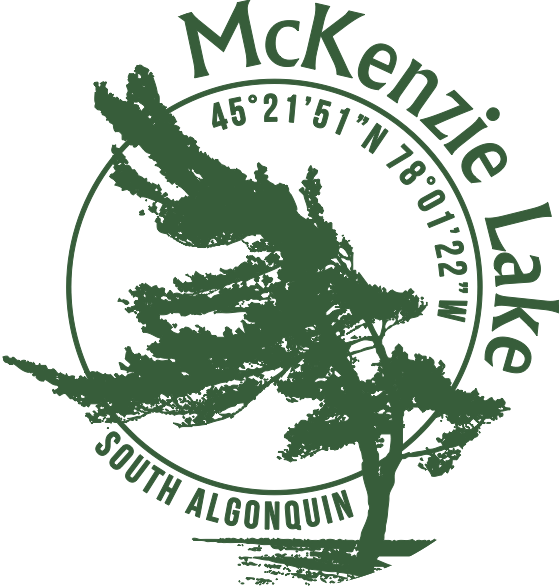Water Quality
3.4.1 Hutchinson Environmental Sciences Ltd. were hired by the McKenzie Lake Property Owners Association to assess the water quality of McKenzie Lake. Water quality was assessed through a review of historical data and reports, and water samples which were collected in August 2022.
The water quality of McKenzie Lake is good with low concentrations of nutrients, bacteria and algae, although blue-green algae was observed in the lake on August 16, 2022. The majority of development on McKenzie Lake is true “cottage” development, large homes with manicured lawns to the water’s edge are largely absent. The development character of McKenzie Lake, such as naturally vegetated shorelines, will help to maintain water quality.
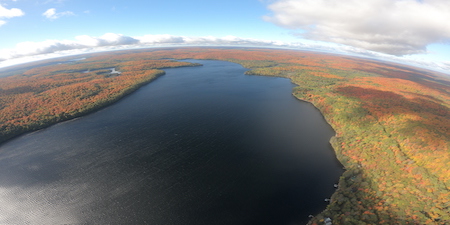
3.4.2 The water quality of McKenzie Lake is generally good, with relatively low concentrations of nutrients, chloride, metals, E. coli, and phytoplankton. Clarity is relatively low for an oligotrophic lake due to the export of dissolved organic carbon (DOC) from the lake’s forested catchment. Clarity has decreased over time which could be the result of increasing DOC concentrations, consistent with trends in south-central Ontario lakes over a similar timeframe (Palmer et al. 2011).
3.4.3 There is good habitat for cold-water fish in the lake’s relatively well-oxygenated hypolimnion. Internal phosphorus loading appears to be of limited magnitude based on available data. The only two water quality guideline exceedances were for iron (just above the sediments) and nitrite (on a single date in 2004; possibly an erroneous value).
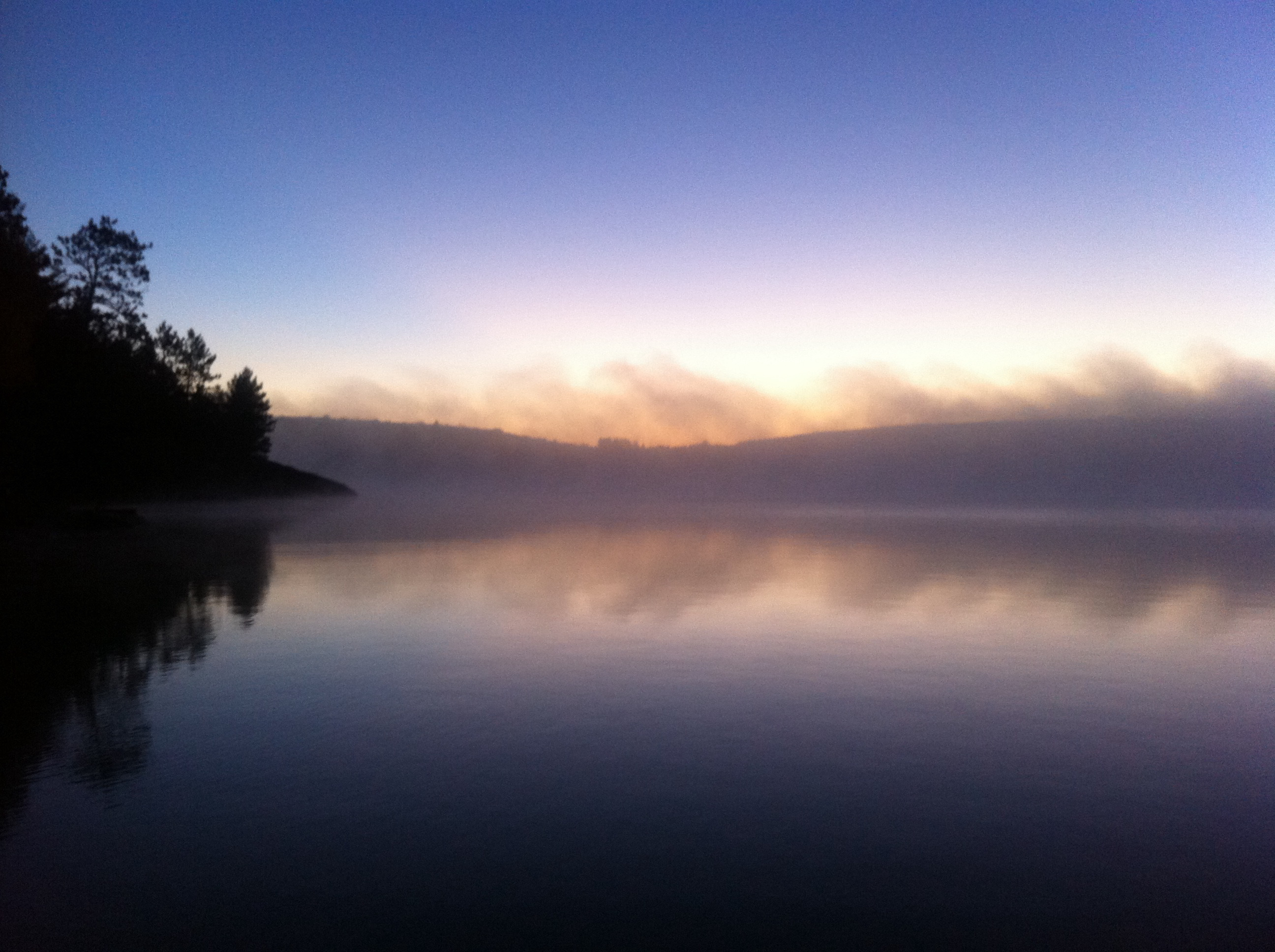
3.4.4 Climate change, brownification (i.e., increased DOC), and changes to hydrology have resulted in conditions conducive to the proliferation of nuisance and harmful algal blooms. In Central Ontario, this includes a marked recent increase in algal blooms in low-nutrient lakes. The observation of aggregations of a potentially toxic, bloom-forming cyanobacterium of the genus Planktothrix is of some concern, but toxic blooms have not been reported (to our knowledge) and this genus is known to thrive in low-light environments, which may explain its presence in the relatively brown waters of McKenzie Lake.

3.4.5 The majority of existing development on McKenzie Lake is typical of true “cottage” development and is well-buffered; intense waterfront development (e.g., large homes, vast impermeable surfaces, wake-surfing boats, and manicured lawns) is largely absent. Responsible waterfront development often requires the enforcement of appropriate planning policies such as those present in the Official Plan, and stewardship/education initiatives implemented by volunteer groups such as McKLPOA. The development character on McKenzie Lake, including intact vegetated shoreline buffers, will help to maintain water quality. Protective Township Official Plan policies are in place which will help to mitigate development-related impacts if the policies are implemented through education and/or enforcement.
Water Quality Characterization
Data Collection
3.4.6 Historical data for McKenzie Lake were obtained from the McKLPOA archives (courtesy of Chris Ursulak), the Ministry of Environment, Conservation, and Parks (MECP) Technical Support Section–Eastern Region (courtesy of Sarah Baxter), and from the MECP’s online data portal for the Lake Partner Program (LPP).
In addition, the lake was surveyed by HESL on 16 August 2022. Field measurements and samples were collected at 3 sites (Figure 1). Temperature, dissolved oxygen (DO), pH, and specific conductance were measured throughout the water column at a 1-m interval using a YSI sonde. Vertical profiles of the chlorophyll-a fluorescence of different phytoplankton groups were recorded using a field fluorometer (bbe FluoroProbe). Samples were collected from the upper mixed layer (surface to Secchi depth) by weighted bottle and from 1-m above the lakebed (“1 mob”) using a Kemmerer sampling device. Water samples were analyzed by ALS Laboratories for a broad suite of standard limnological parameters (nutrients, bacteria, metals, etc.).
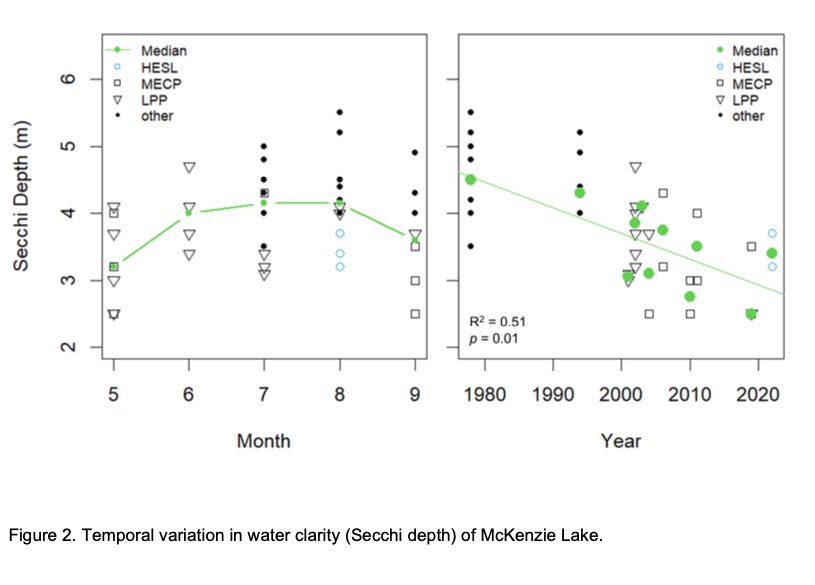
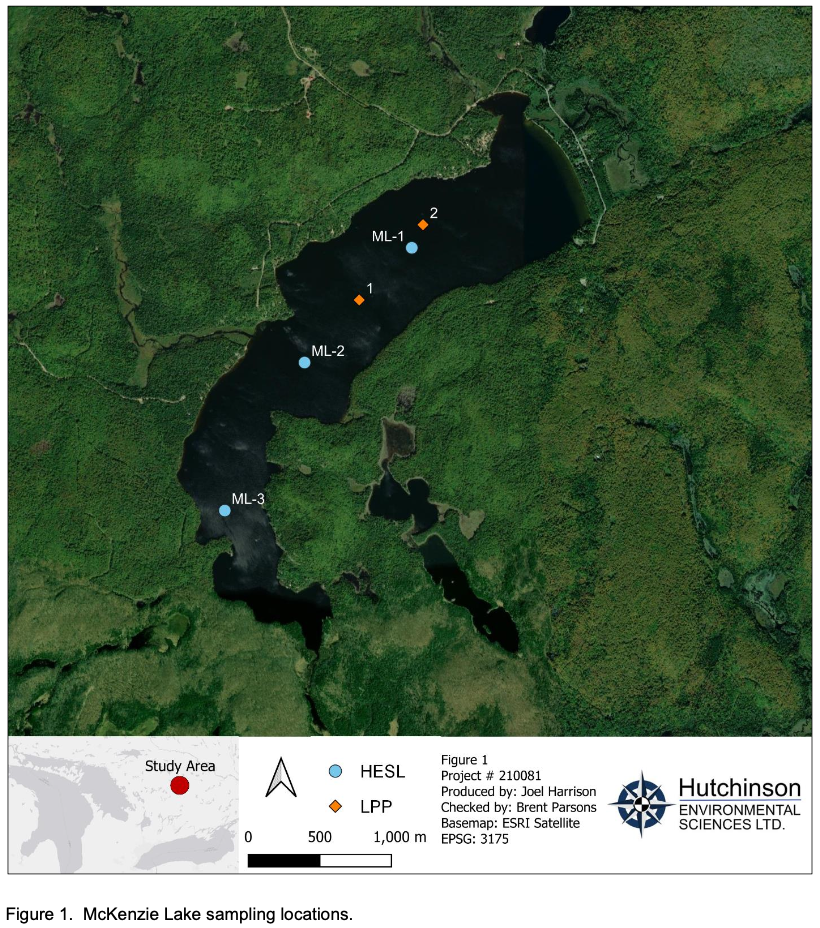
Water Clarity
3.4.7 HESL recorded Secchi depths of 3.7, 3.2, and 3.4 m at sites ML-1, ML-2, and ML-3, respectively, on 16 August 2022. These Secchi depths are indicative of moderate water clarity; this is predominantly due to light absorption by dissolved organic carbon (DOC), the various molecules that impart a “tea-stained” appearance to water. The average DOC concentration of McKenzie Lake was 7.1 mg/L at the time of the HESL survey, higher than the median of 5.6 mg/L observed by MECP for the period 2004–2019 (range: 5.2–7.0 mg/L).
Historical data indicate that transparency was higher in the summer than in the spring or fall (Figure 2), likely reflective of increased DOC supply to the lake during periods of higher runoff. There has been a decreasing trend (~0.04 m per year) in the annual median Secchi depth of McKenzie Lake over the past four decades (R2 = 0.51; p = 0.01; Figure 2); however, there are large gaps in the record prior to 2001, and no significant trend was detected between 2001 and 2022 (R2 = 0.19; p = 0.25) or if only summer (July & August) data are considered (R2 = 0.44; p = 0.15).
Stratification and Dissolved Oxygen
3.4.8 The water column of McKenzie Lake thermally stratifies in the summer, with a surface mixed layer (epilimnion) depth of 5–8 m and a hypolimnion (bottom layer) extending from a depth of approximately 10 m down to the lakebed (Figure 3; Figure 4). The mean volume-weighted hypolimnetic dissolved oxygen (MVWHDO) concentration of the hypolimnion has varied from 6.65 mg/L to 8.74 mg/L during 2004–2022, with lower MVWHDO values corresponding to later dates of assessment during the open-water season (Table 1). These MVWHDO concentrations are above or only slightly (<0.5 mg/L) below the 7 mg/L threshold recommended by the Ministry of Natural Resources and Forestry (MNRF) to ensure high-quality habitat is available for Lake Trout (Salvelinus namycush). MVWHDO was not calculated by HESL for 1985 or 1970 due to the low vertical resolution of the hypolimnetic oxygen data available from these years (Figure 3); however, based on the oxygen concentrations reported, MVWHDO would likely be comparable to that calculated for 2004–2022.
Table 1. Hypolimnetic oxygen concentrations in McKenzie Lake.
Date | Agency | MVWHDO | Range of Hypolimnetic DO | Top of Hypolimnion | Profile Depth |
|---|---|---|---|---|---|
2004-09-02 | MECP | 8.13 | 1.30–8.84 | 11 | 27 |
2004-09-02 | MECP | 6.71 | 1.60–7.22 | 11 | 26 |
2011-09-13 | MECP | 7.08 | 5.82–7.35 | 11 | 25 |
2019-09-17 | MECP | 6.65 | 3.33–7.31 | 10 | 26 |
2022-08-16 | HESL | 8.74 | 2.77–9.17 | 10 | 27 |
Figure 3: Vertical profiles of temperature and DO based on historical provincial monitoring.

Figure 4. Vertical profiles of temperature and DO measured by HESL on 16 August 2022.
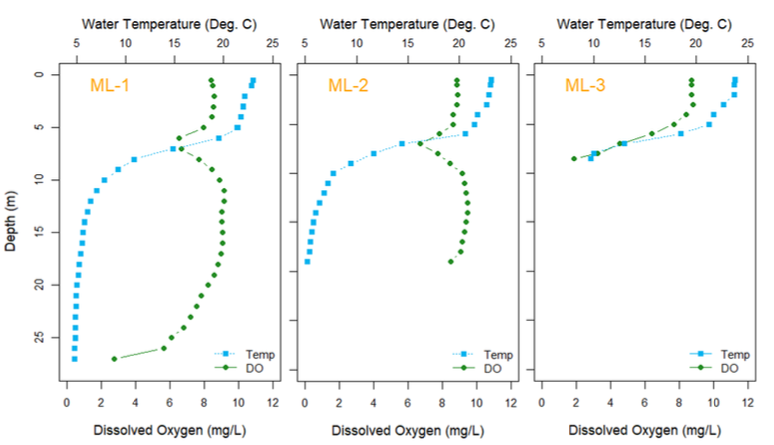
WATER CHEMISTRY
3.4.9 An overview of important lake chemistry characteristics is provided in this section;
To see the full HESL dataset click here: (Appendix 13.2 2022 HESL Water Quality Data)
To see the full MECP dataset click here (Appendix 13.2 2019 MECP Water Quality Data)
General Water Chemistry
3.4.10 McKenzie Lake is a dilute lake, with low suspended solids, low ions/hardness, low alkalinity, and circum- neutral pH (Table 2). These characteristics are common to lakes underlain by the bedrock geology of the Precambrian Shield; the lack of calcium and magnesium carbonates in the watershed soils results in soft water (low ions) with little buffering capacity (low alkalinity). The low concentration of suspended solids (particles) reflects limited phytoplankton biomass (see following sections) and a lack of sediment inputs from eroded soils (as in agricultural areas) or from stormwater (as in urban areas). pH was consistently within the PWQO range of 6.5–8.5 (Table 2).
Table 2. General water chemistry of McKenzie Lake.

Phosphorus
3.4.11 Epilimnetic total phosphorus (TP) concentrations were 6.9, 6.0, and 6.6 μg/L at sites ML-1, ML-2, and ML- 3, respectively, on 16 August 2022. Based on these relatively low TP concentrations, McKenzie Lake can be described as oligotrophic. These concentrations are below the interim PWQO of 10 μg/L recommended for a high degree of protection against aesthetic deterioration (MOEE 1994).
The TP concentrations of August 2022 are within the range historically observed for McKenzie Lake based on provincial monitoring (2–18 μg/L) and very close to the long-term median TP of 6 μg/L (Figure 5). There is no apparent seasonality in McKenzie Lake’s TP concentration (Figure 5), nor has there been a statistically significant trend in annual median TP concentrations since 1978 (R2 = 0.00; p = 0.84) or since more intensive monitoring began in 2002 (R2 = 0.00; p = 0.93).
On certain summer dates (including the HESL survey) samples were collected from the hypolimnion (1 m above the lakebed) in addition to the epilimnetic (surface mixed layer) samples described above to determine if the internal loading of nutrients from sediment was present. On these dates, the hypolimnetic TP (median: 10.3 μg/L; range: 8.0–14.3 μg/L; n = 8) was generally higher than epilimnetic TP (median: 6.3 μg/L; range: 5.0–9.0 μg/L; n = 8); while the difference is statistically significant (based on a paired T test; p < 0.01), the difference in concentrations was relatively small, at only 3.9 mg/L.
In summary, the TP concentration of McKenzie Lake is relatively low, stable, and does not appear to be strongly influenced by the lake’s sediments (i.e., internal phosphorus loading is not substantial).
Figure 5. Temporal variation in the epilimnetic total phosphorus concentration of McKenzie Lake.
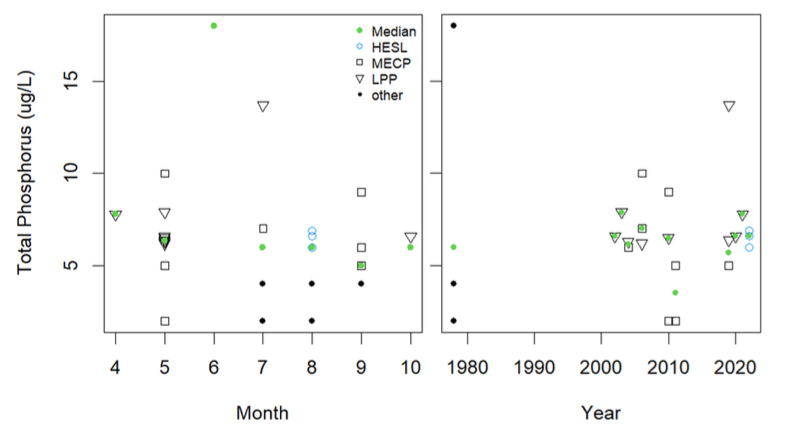
Nitrogen
3.4.12 Inorganic nitrogen concentrations were low on 16 August 2022, with ammonia, nitrite, and nitrate concentrations well below guidelines; similar results have been obtained via MECP monitoring (Table 3), with the exception of a single CWQG exceedance for nitrite on 25 May 2006 (i.e., 0.100 mg-N/L vs. the guideline of 0.060 mg-N/L); this value may represent laboratory error as all other nitrite values reported by MECP were ≤0.005 mg-N/L and nitrite is typically very low in unpolluted lakes (as it is rapidly oxidized to nitrate).
Based on the long-term median TP concentration of 6 μg/L and the median TN concentration of 0.31 mg/L, the TN:TP mass ratio is approximately 52 (equivalent to a molar ratio of 114) which suggests that primary production in McKenzie Lake is constrained by phosphorus availability rather than nitrogen availability (Guildford and Hecky 2000).
Figure 5. Temporal variation in the epilimnetic total phosphorus concentration of McKenzie Lake.

Chloride
3.4.13 Chloride concentration was low when assessed by HESL in August of 2022 (3.5–3.6 mg/L) and MECP in May and September of 2019 (3.2–4.9 mg/L) relative to the CWQG of 120 mg/L. Road salting in lake catchments is the major source of chloride to lakes. The low chloride concentrations in McKenzie Lake are due to the predominance of forest cover and low level of urbanization in the lake’s drainage basin.
Metals
3.4.14 Metal concentrations were generally quite low in McKenzie Lake when assessed by HESL on 16 August 2022. Concentrations were below the detection limit (at all 3 sites) for 18 of the 39 metals quantified. No epilimnetic metal concentration exceeded its PWQO. Iron was 1.3 mg/L (above the PWQO of 0.3 mg/L) in the hypolimnion (i.e., 1 m above the lakebed) at the deepest site (ML-1); this likely reflects release from the sediments and is thus localized, transient, and inconsequential in the context of recreation, household water use, or toxicological effects on aquatic life.
Bacteria
3.4.15 The PWQO for Escherichia coli bacteria is a maximum of 100 E. coli per 100 mL based on a geometric mean calculated from 5 samples collected from one site within a month (MOEE 1994). The only E. coli data available for McKenzie Lake (to our knowledge) are from our 2022 survey; thus, quantitative evaluation of McKenzie Lake’s E. coli concentrations relative to the PWQO is not possible. Based on the E. coli concentrations of August 2022 (i.e., ≤1 MPN1/100 mL at all sites), and what is known about the lake in general, it is considered likely that McKenzie Lake would usually meet the PWQO for E. coli (i.e., does not have serious issues with fecal contamination).
Phytoplankton
3.4.16 Chlorophyll-a concentration is relatively simple and inexpensive to determine and for this reason it is a commonly used surrogate for phytoplankton biomass in lakes. The chlorophyll-a concentrations within the epilimnion of McKenzie Lake were 3.5, 3.9, and 3.2 μg/L at sites ML-1, ML-2, and ML-3, respectively, on 16 August 2022. These chlorophyll concentrations are indicative of moderate phytoplankton biomass, which is consistent with the lake’s relatively low nutrient concentrations (see Section 2.4). The chlorophyll concentrations observed in 2022 are within the ranges determined via provincial monitoring in 1978 (avg. = 2.0 μg/L; range = 1.0–5.1 μg/L) and 1994 (avg. = 4.0 μg/L; range = 1.5–15.5 μg/L), suggesting that no major changes in trophic status have occurred over the past 4 decades.
Based on fluorescence, green algae (and possibly euglenoids) comprised the majority of the phytoplankton community on 16 August 2022, with cryptophytes, chrysophytes, diatoms, dinoflagellates, and cyanobacteria collectively comprising less than 25% of the total estimated biomass (Figure 6).
Macroscopic aggregations of phytoplankton (i.e., large particles) were observed dispersed throughout the water column on 16 August 2022. Macroscopic aggregations of phytoplankton have also been observed by residents in recent years (Ursulak, C., personal communication, July 13, 2023). A sample was collected from site ML-3 and the cells (Figure 7) have been tentatively identified by HESL as belonging to the genus Planktothrix (aka Oscillatoria2), a group of filamentous cyanobacteria (“blue-green algae”) that is commonlyobserved in temperate lakes; species of this genus can form surface blooms and may produce toxins (Komárek et al. 2003), predominantly the hepatotoxin microcystin (Kurmayer et al. 2016). However, as noted above, cyanobacteria did not constitute a large fraction of the phytoplankton community at the time of the HESL survey; the majority of the phytoplankton were eukaryotes (algae), which do not produce toxins or form surface blooms in lakes and are an important component of aquatic food webs.
(1) ALS Laboratories is now reporting E. coli in MPN (“most probable number”) as well as CFU (“colony forming units”); the different units correspond to different analytical protocols.
(2) The taxonomy of the genus Planktothrix is somewhat ambiguous; the genus is considered valid under the International Code of Botanical Nomenclature, but its species are still considered part of the genus Oscillatoria according to the International Code of Nomenclature of Prokaryotes (Kurmayer et al. 2016).
Figure 6. Epilimnetic (0–5 m) phytoplankton community composition of McKenzie Lake on 16 August 2022, as inferred from FluoroProbe profiles.

Figure 7. Cyanobacterial filaments collected from McKenzie Lake on 16 August 2022.

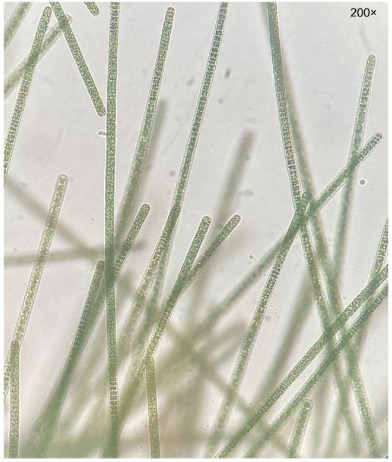
Water Quality Summary
3.4.17 The water quality of McKenzie Lake is generally good, with relatively low concentrations of nutrients, chloride, metals, E. coli, and phytoplankton. Clarity is relatively low for an oligotrophic lake due to the moderate DOC concentration of the water caused by export of organic carbon from the lake’s forested catchment. Clarity has decreased over time which could be the result of increasing DOC concentrations which have increased in south-central Ontario lakes over a similar timeframe (Palmer et al. 2011).
There is good habitat for cold-water fish in the lake’s relatively well-oxygenated hypolimnion. Internal phosphorus loading appears to be of limited magnitude based on available data. The only two water quality guideline exceedances were for iron (when measured just above the sediments) and nitrite (on a single date in 2004; possibly an erroneous value).
Climate change, brownification (i.e., increased DOC) and changes to hydrology have resulted in conditions conducive to the proliferation of nuisance and harmful algal blooms. In Central Ontario, this includes a marked recent increase in algal blooms in low nutrient lakes. The existing scientific body of literature suggests that the conventional understanding and management of algal blooms, that is based on controlling phosphorus concentrations in the water column, is not adequate to manage the development of oligotrophic blooms in nutrient-poor lakes (Reinl et al. 2021). The observation of aggregations of a potentially toxic, bloom-forming cyanobacterium of the genus Planktothrix is of some concern, but toxic blooms have not been reported (to our knowledge) and this genus is known to thrive in low-light environments (Kurmayer et al. 2016), which, with its relatively brown waters, may explain its presence in McKenzie Lake.
v1.0
